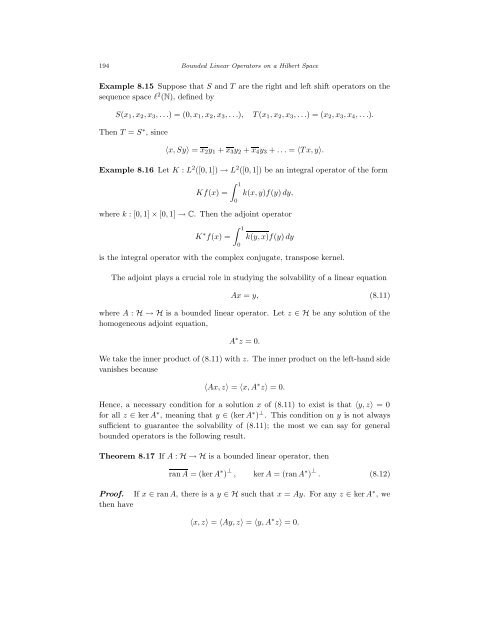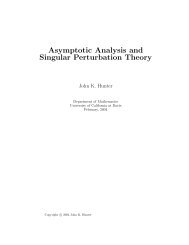Bounded Linear Operators on a Hilbert Space
Bounded Linear Operators on a Hilbert Space
Bounded Linear Operators on a Hilbert Space
Create successful ePaper yourself
Turn your PDF publications into a flip-book with our unique Google optimized e-Paper software.
194 <str<strong>on</strong>g>Bounded</str<strong>on</strong>g> <str<strong>on</strong>g>Linear</str<strong>on</strong>g> <str<strong>on</strong>g>Operators</str<strong>on</strong>g> <strong>on</strong> a <strong>Hilbert</strong> <strong>Space</strong><br />
Example 8.15 Suppose that S and T are the right and left shift operators <strong>on</strong> the<br />
sequence space ℓ 2 (N), defined by<br />
S(x1, x2, x3, . . .) = (0, x1, x2, x3, . . .), T (x1, x2, x3, . . .) = (x2, x3, x4, . . .).<br />
Then T = S ∗ , since<br />
〈x, Sy〉 = x2y1 + x3y2 + x4y3 + . . . = 〈T x, y〉.<br />
Example 8.16 Let K : L2 ([0, 1]) → L2 ([0, 1]) be an integral operator of the form<br />
1<br />
Kf(x) =<br />
0<br />
k(x, y)f(y) dy,<br />
where k : [0, 1] × [0, 1] → C. Then the adjoint operator<br />
K ∗ f(x) =<br />
1<br />
0<br />
k(y, x)f(y) dy<br />
is the integral operator with the complex c<strong>on</strong>jugate, transpose kernel.<br />
The adjoint plays a crucial role in studying the solvability of a linear equati<strong>on</strong><br />
Ax = y, (8.11)<br />
where A : H → H is a bounded linear operator. Let z ∈ H be any soluti<strong>on</strong> of the<br />
homogeneous adjoint equati<strong>on</strong>,<br />
A ∗ z = 0.<br />
We take the inner product of (8.11) with z. The inner product <strong>on</strong> the left-hand side<br />
vanishes because<br />
〈Ax, z〉 = 〈x, A ∗ z〉 = 0.<br />
Hence, a necessary c<strong>on</strong>diti<strong>on</strong> for a soluti<strong>on</strong> x of (8.11) to exist is that 〈y, z〉 = 0<br />
for all z ∈ ker A ∗ , meaning that y ∈ (ker A ∗ ) ⊥ . This c<strong>on</strong>diti<strong>on</strong> <strong>on</strong> y is not always<br />
sufficient to guarantee the solvability of (8.11); the most we can say for general<br />
bounded operators is the following result.<br />
Theorem 8.17 If A : H → H is a bounded linear operator, then<br />
ran A = (ker A ∗ ) ⊥ , ker A = (ran A ∗ ) ⊥ . (8.12)<br />
Proof. If x ∈ ran A, there is a y ∈ H such that x = Ay. For any z ∈ ker A ∗ , we<br />
then have<br />
〈x, z〉 = 〈Ay, z〉 = 〈y, A ∗ z〉 = 0.
















